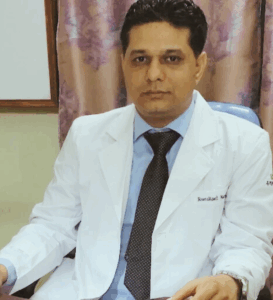Unicondylar knee replacement, also known as partial knee replacement, is a surgery in which doctors only remove the damaged tissue or bone from the knee joints.
In other words, doctors replace only one side of the knee, i.e., either the inner part (medial) or the outer part (lateral).
Moreover, this surgery preserves the rest natural bones and tissues in the knee joints.
However, is one of the most common, effective, and alternative to total knee replacement.
As unicondylar knee replacement recovery time is low and less painful, young people also prefer it.
According to studies, people with 5% to 6% of the arthritic knee can go for unicondylar knee replacement.
Enough of the introduction! Now, let’s head to its causes of it in the coming section.
Contents
Causes
The exact causes of unicondylar knee replacement are unknown.
But, the best Knee Doctor in Patna has stated some factors that are commonly associated with it, including:
- Increased body weight.
- Injury or trauma in knee joints.
- Knee Fracture.
- Inflamation of joints.
Thus, these are the factors that are usually seen in partial knee replacement cases.
However, if you suffer from partial knee damage, you must consult a doctor to know its cause.
Symptoms
These are the symptoms of unicondylar knee replacement:
- Severe and regular pain in knee joints.
- Stiffness (Common in active people).
- Mobility issue (unsteadiness while walking, standing, or more).
- Swelling and inflammation (It may be the result of trauma, overuse injuries, or an underlying disease or condition).
- Difficulty in doing regular activity.
Note– If you notice any of them, you must consult the best orthopedic doctor in Patna.
Potential Candidates for Unicondylar Knee Replacement
If you suffer from advanced osteoarthritis, you must consult a doctor for unicondylar knee replacement.
That saying, there are many other factors that can make someone a potential candidate for it, including:
- Your arthritis should be in one compartment of your knee.
- Notice significant knee stiffness.
- Knee pain doesn’t subside with nonsurgical treatment such as icing, anti-inflammatory medications, and more.
- Instability and lower range of motion.
- Your doctor suggests going for knee pain.
Thus, these are some factors that make you eligible for unicondylar knee replacement.
However, there could be some other reasons too and that depends upon your medical condition.
Unicondylar Knee Replacement Treatment
![]()
If you are a potential candidate for unicondylar surgery, your doctor may suggest treatment.
Moreover, the doctor will suggest you some non-surgical or surgical treatment, depending on your condition.
So, let’s see some non-surgical unicondylar knee replacement treatment first.
- Medications– Doctors prefer some nonsteroidal anti-inflammatory drugs (NSAIDs) to reduce knee pain.
- Physical therapy is also helpful in reducing knee pain.
- Exercise can help knee joints improve function, range of motion, strength, and overall condition of the knee.
- Weight loss is beneficial for reducing pressure on knee joints.
- Injections help to reduce inflammation and knee pain in a trice of time.
Thus, these are some non-surgical ways to treat unicondylar knee replacement.
However, if you don’t notice any positive results from these non-surgical treatments, you must consult a doctor and opt. for surgery.
So, let’s see the surgical treatment of unicondylar knee replacement.
This surgery includes several steps, including:
- Diagnosing problems through X-rays and patient medical history.
- After that, the doctor will either apply either general or spinal anesthesia.
- The doctor makes an incision near the affected part. (Through this, the doctor gets access to the affected part of the knee).
- After confirming the affected region, the doctor will excise small pieces of damaged cartilage and bone.
- Now, the compartment of bone is replaced by metal prosthetics (fix by bone cement).
- These implants are separated from bones with the help of a plastic insert to make joint motion smooth.
So, this way the doctor performs the unicondylar surgery.
And if you are still not convinced to go for it, you must take a look at its advantages.
Advantages of Unicondylar Knee Replacement
There are several advantages of unicondylar surgery, including:
- As it doesn’t include a complete knee joint, most of your natural bones and tissues are preserved.
- Its recovery time is low because of minimal-invasive surgery (MIS).
- Lower blood loss during surgery.
- Better knee function and range of motion.
- Reduced post-operative problems, especially pain.
Thus, these are some advantages that you will notice after unicondylar knee surgery.
However, many people want to know the disadvantages of unicondylar knee replacement surgery.
For their information, doctors don’t state any major disadvantages.
Yet, you may feel some knee joint stiffness, little pain, or more, but they don’t last long.
So, you need not worry about it, just consult the best orthopedic doctor in Patna and go for the surgery.
Hence, this is everything you need to know about unicondylar surgery.
Conclusion
Unicondylar surgery, also known as partial knee replacement, is an alternative to total knee replacement.
In short, it deals with a particular part of the knee joint, i.e., either the medial or the lateral.
Therefore, if you feel pain, stiffness, reduced mobility, or any symptom, you must consult a doctor and get treatment.
You can also read:
Is Knee Replacement Treatment Worth Undergoing?
Can Knee Replacement Cause Restless Leg Syndrome?



